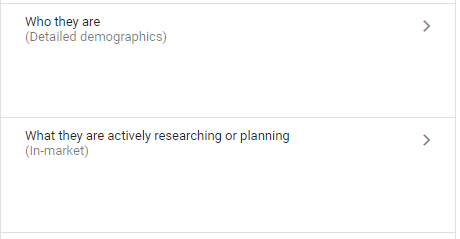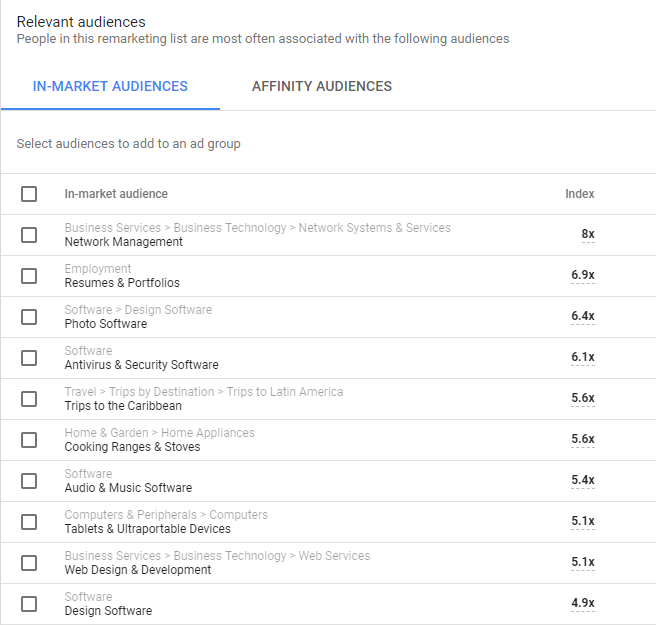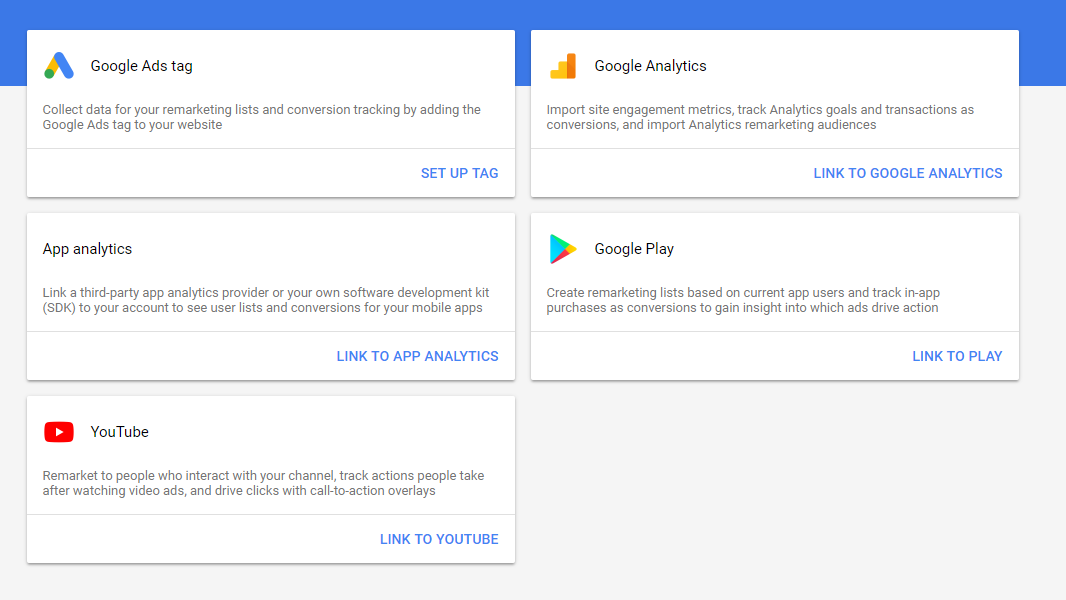Creating Advanced Audiences for Google Ads
Guest post by Mike Nelson, Four15 Digital
A couple years ago, pretty much every Google rep was telling advertisers to add audiences into their search campaigns as audience overlays (“observation audiences”). This was mostly justified by saying it was a “best practice” to follow, but it wasn’t entirely clear why.
Well, after some data collection, we’ve come to understand the reason why you should add in audience overlays to your search campaigns is because there can be large differences in conversion rate (CVR) data across audiences, similar to what you’d see across devices, search terms, geos, etc. For example, audiences classified as “past purchasers” are more likely to convert on a very generic query than a new user would on a query that seems to be bottom of the funnel.
Illustrated here is some sample data for non-branded ranges you may see for a typical e-commerce brand.

When analyzing this matrix, our view of search changes a lot. We used to think the query was the most important influencer on CVR—now, it’s clear that the user’s past relationship with our brand (or lack thereof) is at least as important as what they search!
Google’s Investment in Audiences
Facebook and other social channels have led the pack in user data for a while, and Google has seen the need to improve in order to keep pace.
What Google has had for some time is a variety of options for your 1st party data efforts. This can come from from different tools and sources—i.e. Google Ads, Google Analytics, YouTube Channel Views, Your App’s users and Customer lists (more on these later).
What Google has been doubling down on recently is their data. To advertisers, these are “2nd party” data sources (we assume all the data comes from Google, and they are not aggregating from other sources as well, which would make it a 3rd party data source).
In search, specifically, these come bundled in a package called “in-market” audiences. Sample options include:
- Demographic data
- Installed app categories
- New mobile devices
- Similar audiences (to one of your 1st party lists)
Google nicely puts most of these options into two categories, shown below:

You’ll also find similar users under the 3rd category they offer:

Similar audience lists are automatically created whenever you make your own audience in the audience manager.
So, with all these options, you should definitely be adding in some Google audience sources to search campaigns.
As a baseline, you can start with similar users to your audience(s), and also review the in-market recommendations from Google in your audience manager, such as the one shown below (called “audience insights”).

In Gmail, Display and YouTube, there are other audience options as well, such as affinity audiences, custom-intent audiences and more. These can’t be used as search overlays, but can be set as targeting options for those networks.
1st Party Audience Sources (remarketing)
More important than Google data, however, is your own data. As briefly mentioned above, there are many ways to get this data:
- Google Ads
- Google Analytics
- YouTube Channel Views
- Your App’s users
- Customer lists

For most brands, the most important sources ended up being your customer lists (email lists), Google Ads, and Google Analytics. Below, we explore some pros and cons of pulling from these various sources.
Pros and Cons of Google Ads Source
Google ads lists can be made only based on page views, not on customer engagement. This also includes the ability to set a window, i.e. how long since they have been to your site. Frankly, this is a somewhat weak ability, though it allows a logic such as “I want to serve an ad to people who have seen my “blue shoes” pages before,” it does not allow a logic based on engagement such as, “I want to serve an ad to people who were on my site longer than 3 minutes.” One added benefit of Google Ads as a data source is that you can pretty much have as many lists you want—I’m not actually sure the maximum, but it’s at least 1500!
Pros and Cons of Google Analytics Source
GA is a great source of data, as it lets you create engagement based lists. Some common ones to consider are:
- New users vs return users
- Viewed more then X pages
- Stayed on my site longer then Y seconds
- Purchased a product (if you’re not able to set this up as a page view goal/event)
- Completed an action on my site (requires GA goal to be setup)
That said, there are two major downsides of using GA audiences:
- There is a limit of 20 audiences per property
- These lists are not compatible with Gmail ads in some cases.
Pros and Cons from Email Uploads
Uploading here is pretty straightforward. Google gives you an easy to use template (learn more here).
While most past customers can be captured via the Google Ads or Analytics tag, the email list will ensure the data is not lost along the way (e.g. via cookie cleansing, etc.). That said, it does introduce a match rate variable, and your match rate may be as low as 20% and is not likely to be higher than 70%. So, this is not a very bulletproof method.
Another pro of customer match, however, is you’re able to upload many lists into Google. You may go this route if you’ve approached your 20 list maximum on Analytics.
Of course, if you are actually using 3rd party data to creating a targeting pool, this would be a nice advantage of customer list, but this would violate some of the policies Google has, and they are starting to enforce these sorts of things much more aggressively after GDPR and other data concerns from users. There are also additional restrictions and approvals shown here:
“When using Customer Match, you may only upload customer information that you collected in the first-party context—i.e., information you collected from your websites, apps, physical stores, or other situations where customers shared their information directly with you.” Source
Expectations from YouTube audiences
YouTube audiences only build from organic views of your videos; this changed around September of 2018. This will likely limit how useful the YouTube list source is in search, display and elsewhere, since your audience may not be very large.
Additionally, YouTube audiences, in general, don’t perform nearly as well as website visitors or app users. They require a lot more nurturing and should be considered to be relatively unaware prospects unless you have some amazing creative!
Effectively, this serves as a warning to not get too excited about YouTube audiences as 1st party data source.
Creating your Audience Strategy
Hopefully by now you agree:
- Having an audience strategy is important
- Audience strategies are complicated! There are many data sources and decisions to be made.
To map out your plan, we recommend creating a document where you list out the following criteria:
- A handful of in-market audiences based on those with high (and low) affinity scores.
- Several 1st party audiences. Favoring Google Ads as a data source if it’s based on time since visit or certain pages viewed. For example:
- Users who have been on my site in the last 1, 3, 7, 14, 30 or 90 days (Google Ads)
- Users who have spent at least 1 minute, 5 minute, 15 minutes on my site in the last 180 days (Google Analytics)
- Purchasers on my site (One customer upload, one Google Ads list to ensure as many users are captured as possible)
- Users who have viewed 1 page, 1-5 pages, 6-20 pages, 20+ pages (Google Analytics)
- YouTube likers, commenters and video viewers (if you have a lot of organic views. You can also segment these by which videos were viewed if you have a large enough audience)
- Your app users
With all this data, really consider using tCPA to manage your bidding, because it’s simply too many data layers to manage manually. tCPA will also look at more things then you’ve added in yourself.
That said, before even getting to this point, you should make sure you have clear business goals. This will inform your audience strategy:
- Do you want to invest in prospecting new users on search and display? If not, then limit your ads only to remarketing.
- Conversely, some folks are convinced that incrementality of any form of remarketing is too low (I’d disagree, especially on search!) but no problem, negate your 1st party audiences in your campaigns.
- Maybe your brand is all based on your amazing YouTube content! Invest in making more content, and limit ad serving only to your YouTube viewers if you’ve got limited budget.
Although each business is different, with the knowledge framework in this article you’ll be able to arm Google’s machine learning system (tCPA) or your SEM account manager with enough audience information to make much wiser investment decisions through better bidding.
